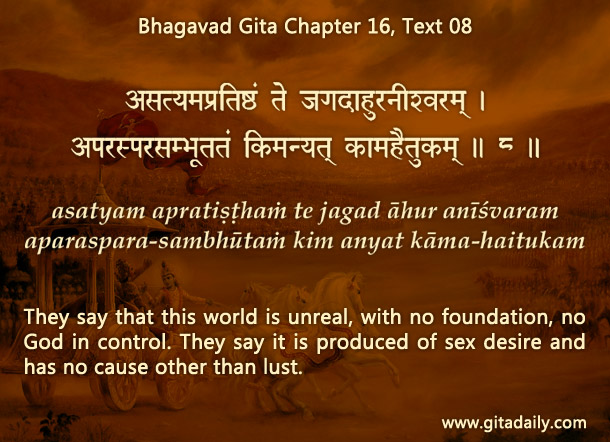A contemporary intellectual trend is deconstructionism, which some nihilists appropriate to invent all sorts of creative and destructive interpretations of things. Nihilists argue that there is no Truth, only truths. Texts have no inherent meaning. Readers can assign to texts whatever meaning they want. At its extreme, nihilistic deconstructionism can imply that anything can mean anything.
But the notion that anything can mean anything makes meaning itself meaningless. If any word can mean what any other word means, then no word means anything. Ultimately, nothing means anything. The statement that texts have no inherent meaning can mean anything, even its opposite: that texts do have inherent meaning. The morass of meaninglessness which nihilists hold lies below everyone else’s words opens up below their own words too.
The Bhagavad-gita spoken thousands of years ago foresees the emergence of such rabidly nihilistic ideas. It deems as demoniac the claim that there is no Truth (16.08) and cautions that such thought-patterns are self-destructive and world-destructive (16.09).
Despite its castigation of nihilism, Gita wisdom agrees with deconstructionists on one significant count: the certainty with which we assign meanings to things is often unwarranted. Our sensory and mental tools for knowledge-acquisition are not as reliable as our materialistic culture has led us to believe. But their unreliability doesn’t necessitate total relativism, as nihilists claim.
Instead, Gita wisdom delineates a time-honored process of bhakti-yoga that activates our dormant capacity for spiritual cognition. When we practice bhakti-yoga diligently, our consciousness rises to the spiritual level, leaves behind the relativity of truth-claims about worldly things, and grants us first-hand perception of higher spiritual reality (09.02). In the court of our heart and head becomes vindicated the supreme verity of life’s defining truths: our spiritual essence, God’s unfailing benevolence and the ecstasy of our eternal bond of love with him.
To know more about this verse, please click on the image
Explanation of article:
Podcast:


Leave A Comment